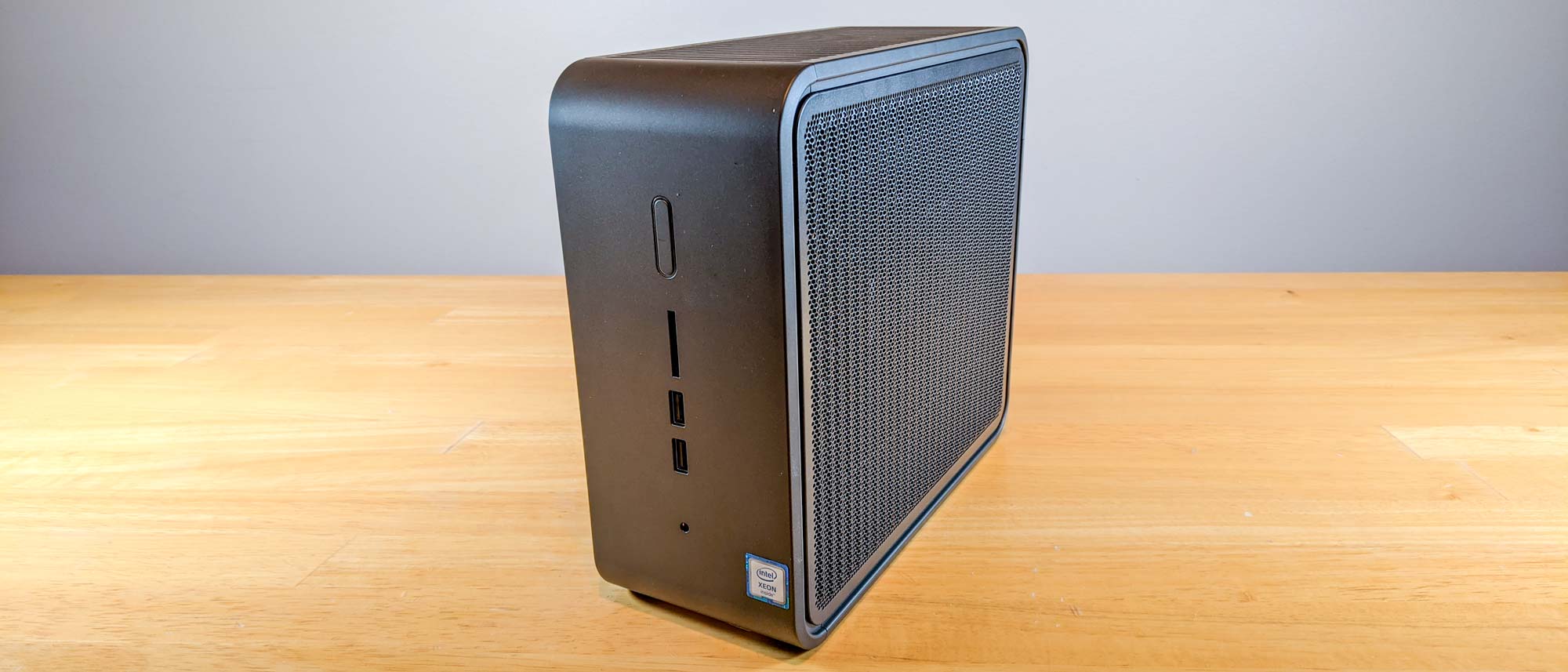Tom's Guide Verdict
The Intel NUC 9 Pro is a workstation mini PC that offers huge power and a surprising amount of upgradability, but fitting all of that into such a small size will cost a pretty penny.
Pros
- +
Powerful workstation processing and graphics
- +
Compact size with upgradability
- +
Innovative tech inside
- +
Internal power supply
- +
Great port selection
Cons
- -
Seriously expensive
- -
Vertical orientation only
Why you can trust Tom's Guide
The Intel NUC 9 Pro offers something exciting in the mini PC world, with a potent workstation crammed into one of the smallest desktop designs you'll ever see with a discrete graphics card inside. The mini PC category is defined by small sizes and Intel's Next Unit of Computing (NUC) has generally followed the basic template of tiny systems, but the NUC 9 Pro (starting at $1,305, $2,868 as tested) steps things up in a big way with Intel Xeon processing, Nvidia Quadro P2200 graphics and room for storage and expansion cards.
Not everyone will need the professional-grade power of a workstation desktop – these systems are best suited to users doing professional work in engineering, finance, medicine and animation – but our Intel NUC 9 Pro review makes it clear that the latest NUC is a compact powerhouse and one of the best mini PCs for power users that's worth the investment.
- See the best laptops you can buy
- Best monitors: Our top picks for every budget
Intel NUC 9 Pro (Quartz Canyon) review: Price and configurations
The NUC 9 Pro is generally sold as a kit by Intel, but you can also buy it as a preconfigured system, with all of the necessary components and software to get started. The Quartz Canyon configuration we used for our review – with an Intel Xeon E-2286M processor, 32GB of RAM, the Nvidia Quadro P2200 graphics card and 1TB of SSD storage, with Windows 10 Pro pre-installed – sells for $2,868.
The NUC 9 Pro is available as a barebones kit, with no RAM, no storage and no operating system. Equipped with a less powerful Intel Core i7-9850H processor and integrated graphics, it sells for $1,305. With the same Xeon E-2286M processor as our review model, it sells for $1,640.
Other non-Pro versions of the NUC 9 are also out there, like the gaming-oriented NUC 9 Extreme (Ghost Canyon), which starts at $999 with an Intel Core i5 9th Gen i5-9300H processor, but scales up to a potent Intel Core i9-9980HK system for $1,649.
Finally, if you want to put the Intel Compute Element into your own case of choice, it's available as a standalone product, in both the Intel Core i7 and Xeon versions offered in the NUC kits, selling for $1153 and $1473, respectively.
Intel NUC 9 Pro (Quartz Canyon) review: Design
The Intel NUC 9 Pro is substantially bigger than previous NUC designs, with a boxy mini tower setup that toes the line between mini PCs and small form factor desktops – much like we saw in last year's Asus ProArt PA90 workstation review. With grills on both sides of the compact chassis, this 9.4 x 8.5 x 3.8-inch desktop is made for performance.
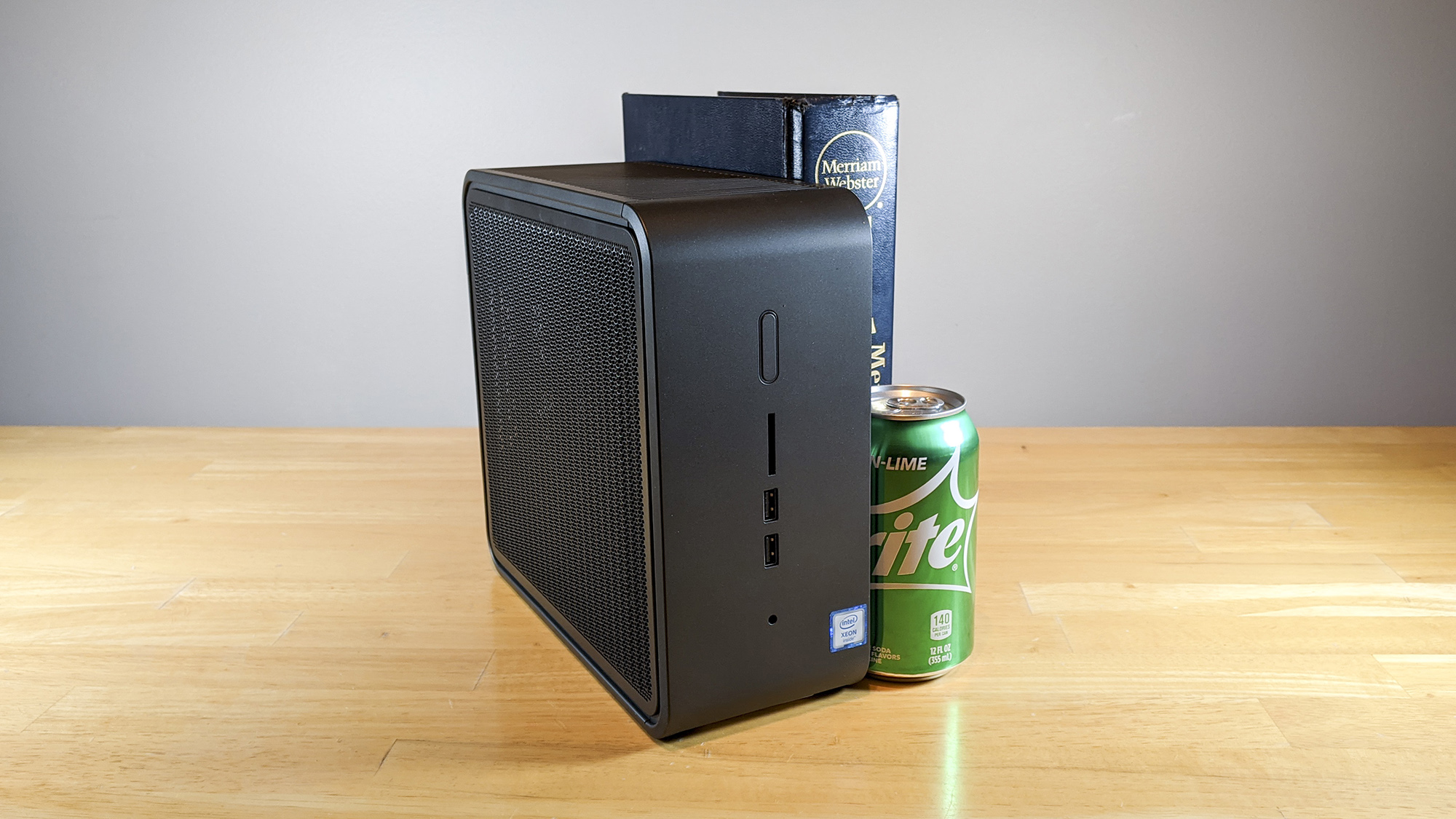
However, where many of the smallest desktop PCs rely on mini-ITX motherboards, The Intel NUC 9 Pro uses Intel's new Compute Element, a cartridge-like enclosed board that contains the motherboard, processor, and other internal components. (More on that below.)
But where the NUC 9 really diverges from previous models is the ability to add a discrete graphics card. In our case that's an Nvidia Quadro P2200, a workstation GPU that offers plenty of muscle for things like media editing and rendering complex models.
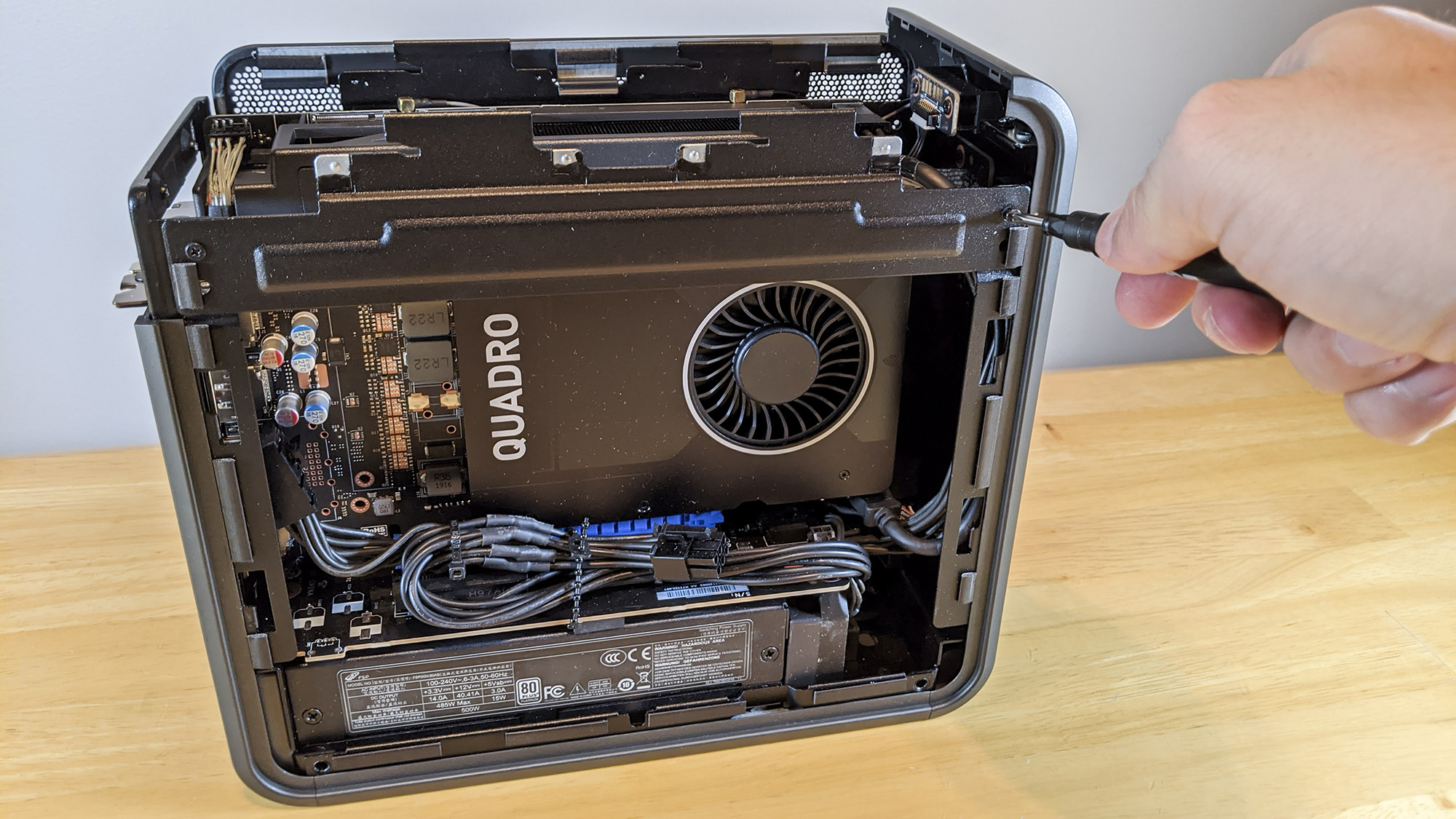
It also features a case that can be fairly easily opened, provided you have a screwdriver. Remove a couple small screws in the back and you can slide off the top cover, and then remove the vented side panel for access to all of the internals.
Additional storage can also be accommodated in the larger case – the NUC 9 Pro has both dual M.2 slots for drives – and PCIe connectivity for a discrete graphics card up to 8 inches in length. Like a traditional desktop tower, the NUC 9 has most of its ports on the back of the system, complete with slots for the additional ports afforded by the GPU.
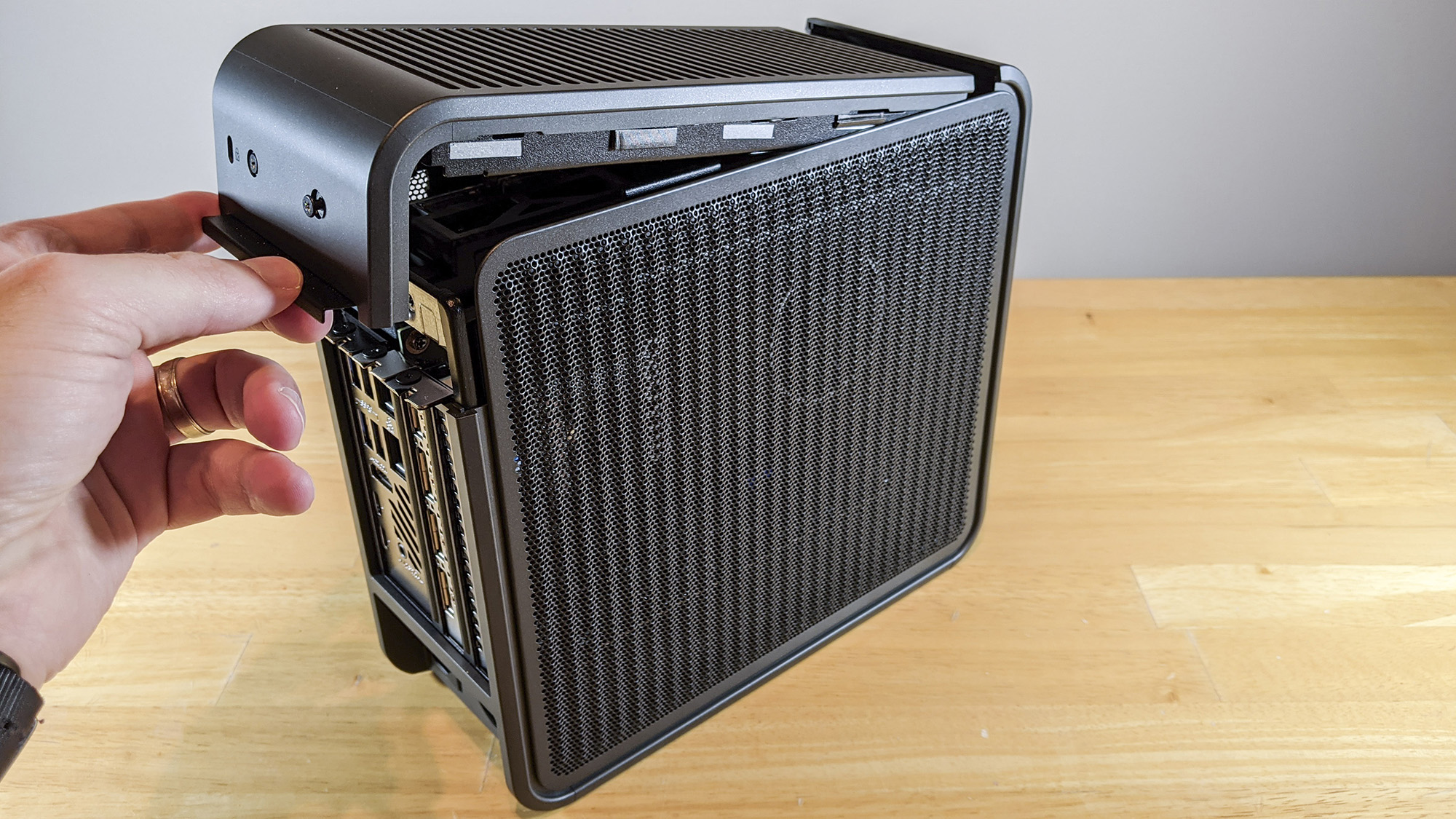
The Intel NUC 9 Pro seems less like Intel's take on the Apple Mac mini – which is what defined many of the early NUC designs – and instead looks like an attempt to wed the NUC concept with the most extreme small form factor systems. The result is a potent workstation class desktop crammed into 4.92 liters of physical space, offering more power per cubic inch than any other desktop we've seen.
That said, the Intel NUC 9 Pro case is really only suitable to the NUC, and it would take a dedicated enthusiast builder to assemble the same components in such a compact case. If you're more interested in owning a tiny but powerful PC than building one, this is definitely the better way to go.
Intel NUC 9 Pro (Quartz Canyon) review: Ports
On the front and back of the NUC 9 Pro you'll find a good number of ports. A total of 6 USB 3.1 Gen 2 slots offer plenty of connectivity for peripherals, as well as two Thunderbolt 3 connectors and two USB 2.0 ports. On the front is also an SD card slot and a 3.5mm stereo headphone jack.
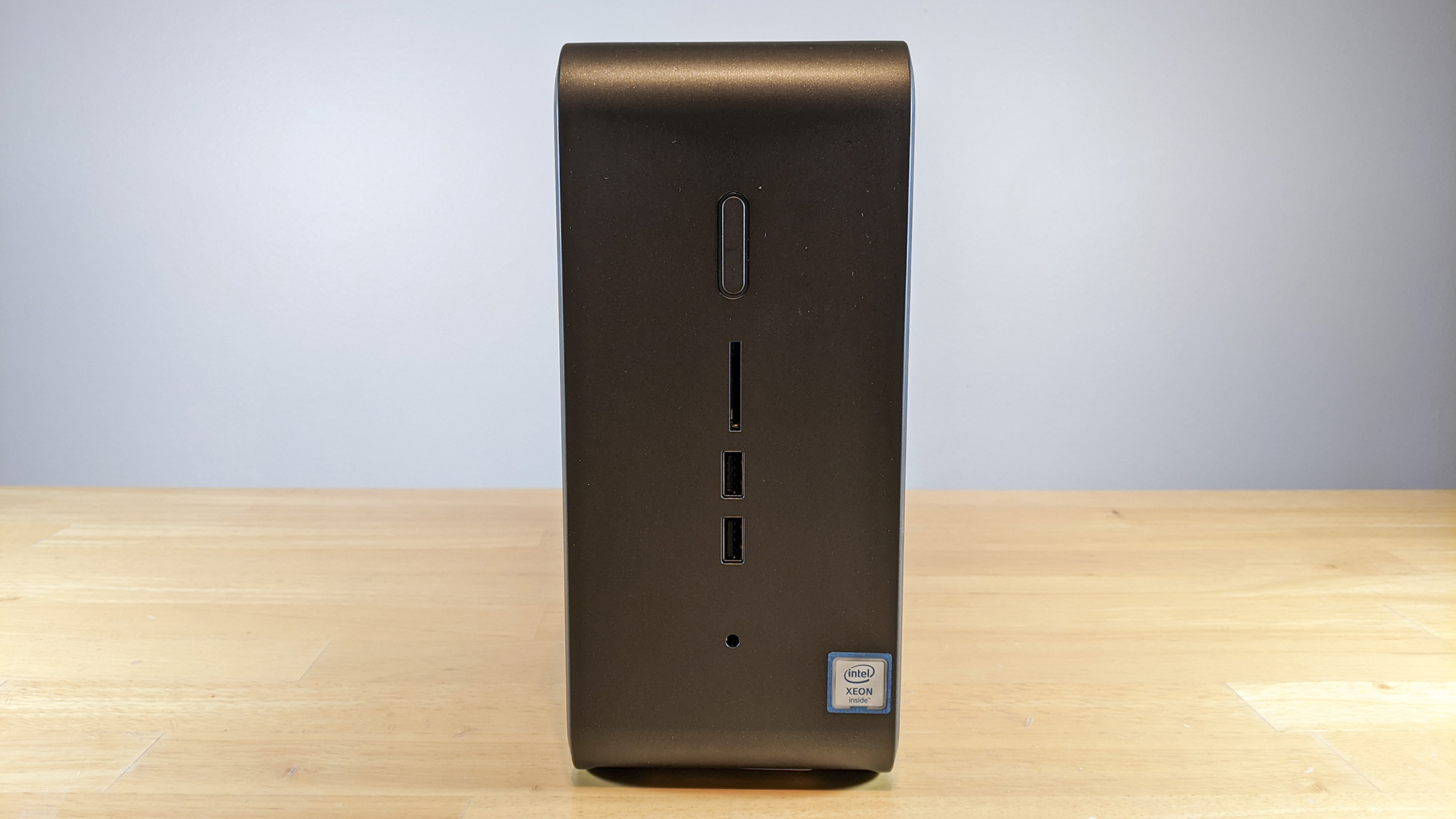
On the back, you'll also find one HDMI port coming off of the main board, along with two 1 Gigabit Ethernet ports. The Nvidia Quadro P2200 graphics card also provides a total of four DisplayPort connections.
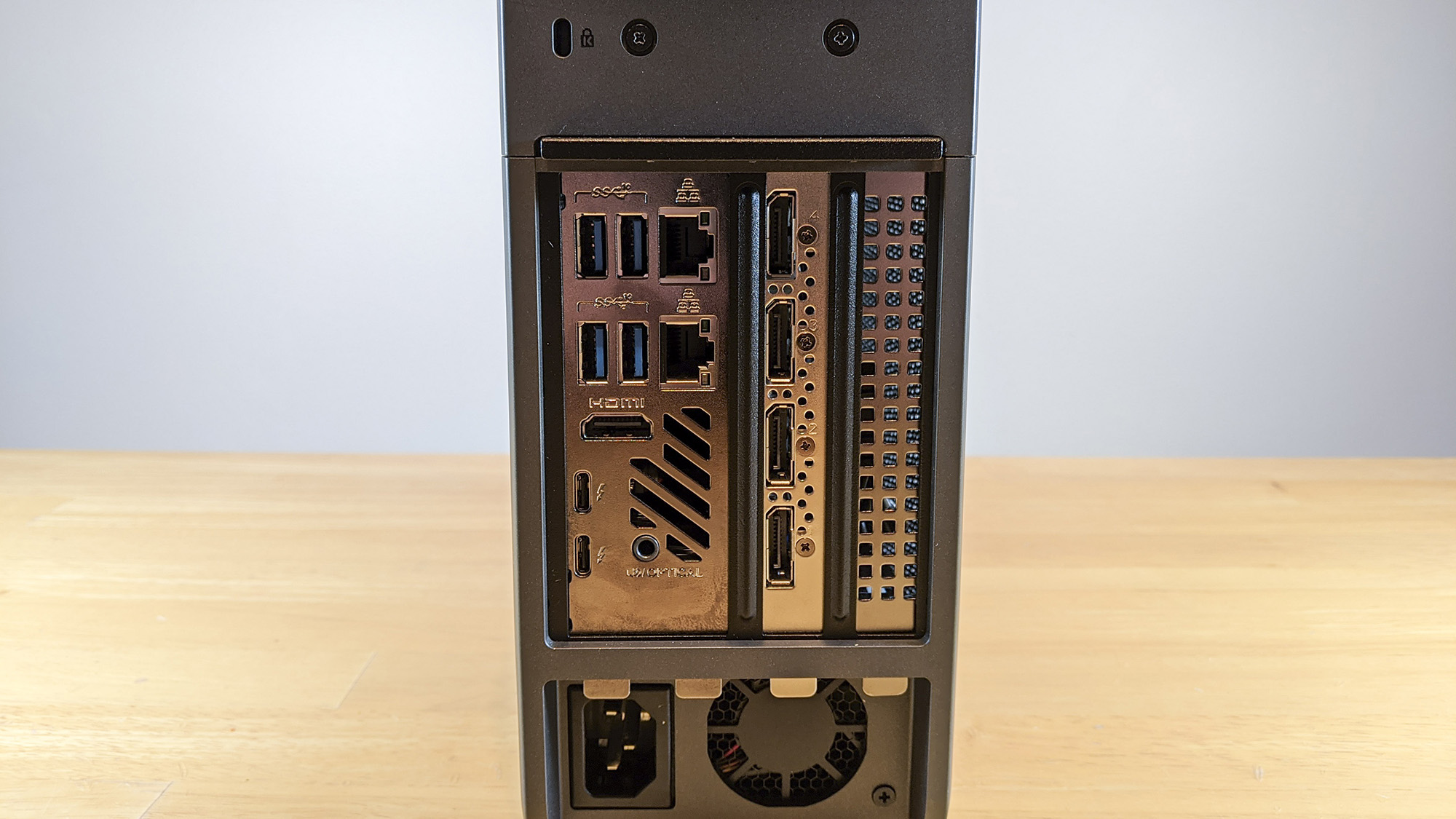
Wireless capability is also built in with 802.11a/b/g/n/ac/ax wireless supporting up to Wi-Fi 6 and Bluetooth v5 for connecting wireless headphones, keyboards and mice, and whatever else.
Intel NUC 9 Pro (Quartz Canyon) review: Intel Compute Element
The latest version of the NUC is built around the Intel Compute Element, a modular system that is essentially a small motherboard packaged more like a graphics card, with the CPU soldered to the board, thermal management built in, and an enclosed design that keeps everything safe and secure. Our unit came equipped with an Intel Xeon processor, packing some intense power into an extremely compact design. Inside the Compute Element you'll also find a pair of SO-DIMM RAM slots, as well as two M.2 slots for storage.
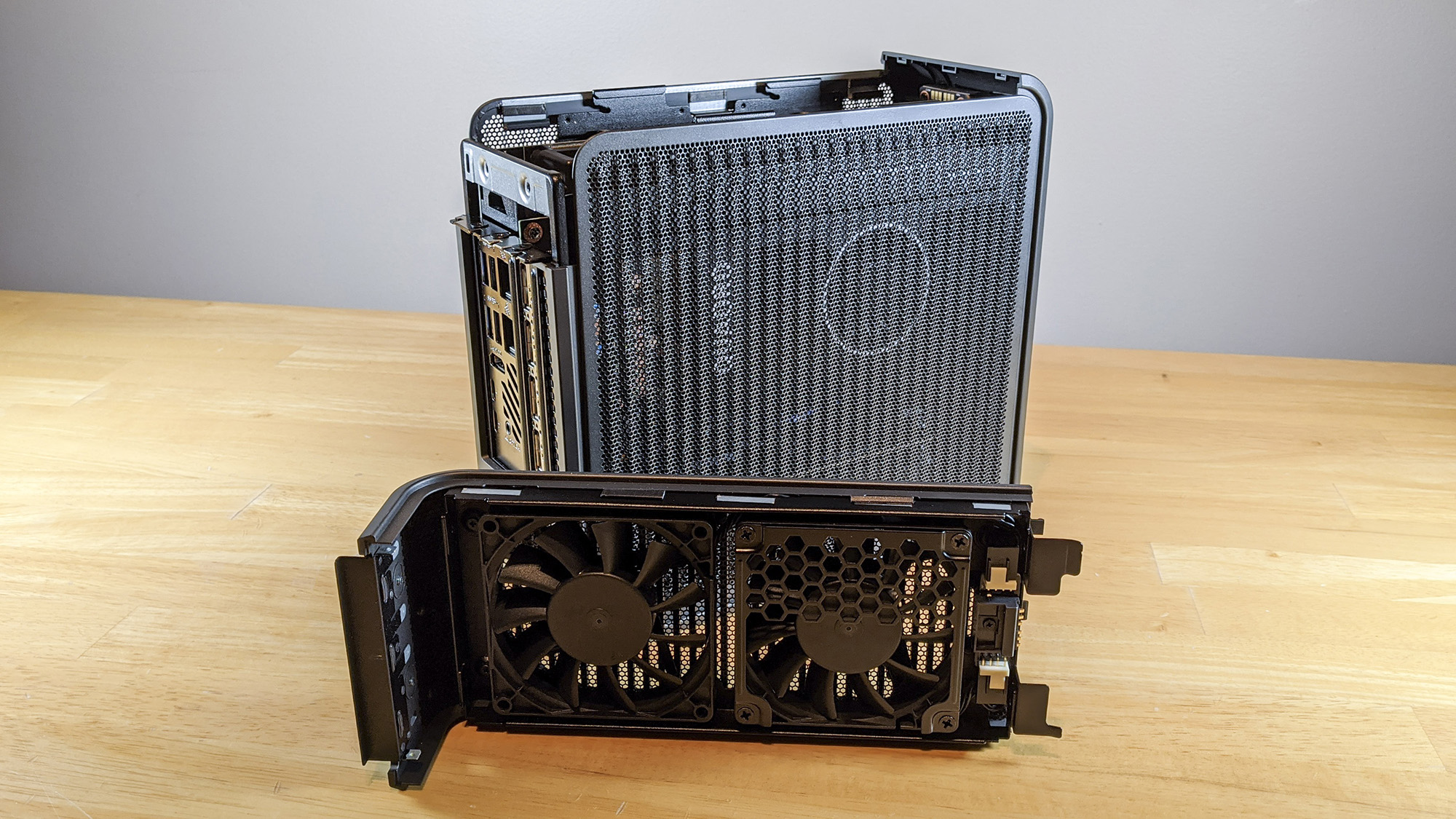
The modular design of the Compute Element means it can even be slotted into a separate PC, connecting with a PCIe slot on an existing motherboard. There's no data transfer between the two, but it provides an independent full-powered PC small enough to slot into another desktop tower. With the Intel Compute Element available with processors ranging from a Core i5 up to the Xeon we see in our own test unit, the NUC 9 Pro offers a huge range of power. The Compute Element runs with a TDP of 95 watts, and is even available as a standalone unit separate from the NUC housing.
Intel NUC 9 Pro (Quartz Canyon) review: Performance
Our unit is outfitted with an Intel Xeon E-2286M processor, a potent 8-core CPU capable of handling 16 discrete processing threads. Paired with Nvidia Quadro P2200 graphics, that puts the NUC 9 Pro firmly in the workstation category, packing the sort of power you might need for engineering and other professional 3D applications. If you need to design a bridge, or a new hip replacement joint, or need to edit lots of high-resolution video, this is the sort of tiny PC you'll want.
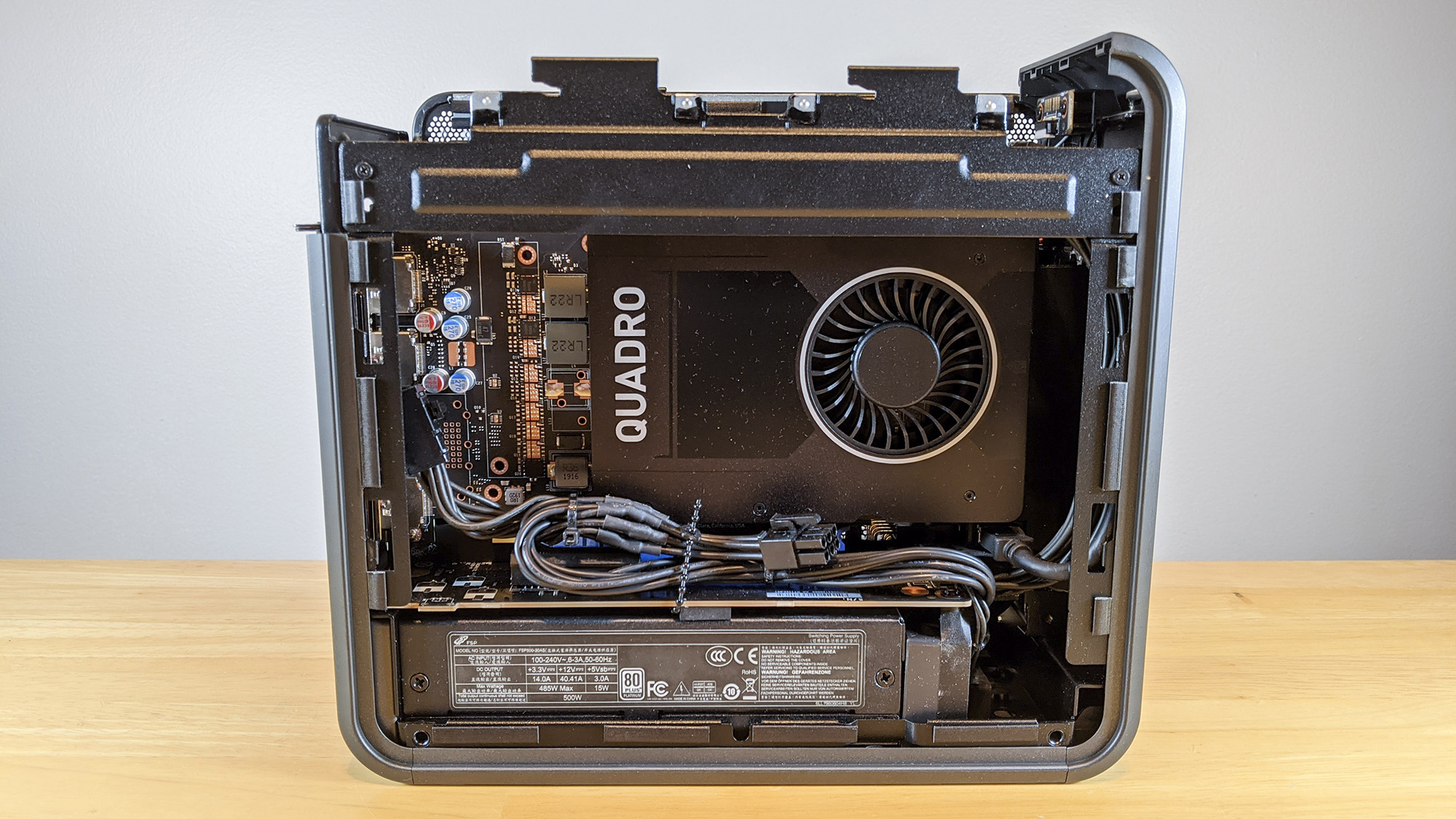
While the processor itself can handle up to 128 GB of RAM, the NUC and the Intel Compute Element inside are limited to 64 GB. Our own unit boasts an respectable 32 GBof RAM, but while that offers plenty of memory for smooth operations, it's nowhere near as impressive as either the board or processor should be able to handle.
In our testing of the NUC 9 Pro, we were easily able to stream 4K video while simultaneously browsing on more than a dozen open Chrome tabs at once without a hint of slowing down. Even as we expanded this to 20, 30 and up to 50 individual chrome tabs, the system handled it all without any noticeable lag.
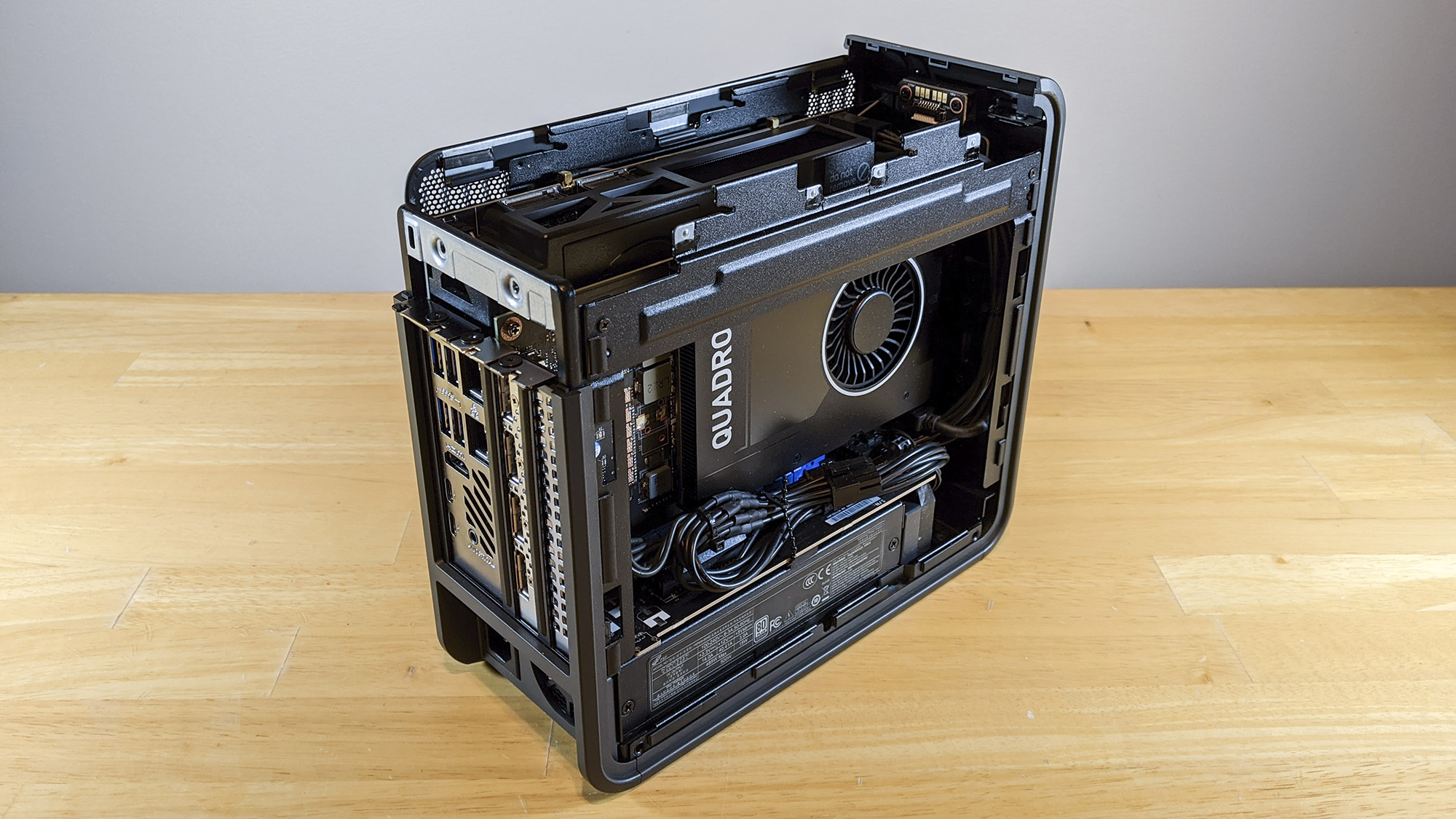
In Geekbench 5.0, the Intel NUC 9 Pro had a category-leading score of 7,985, easily outpacing the likes of the new Apple Mac mini with the M1 processor, which scored 6,005 points, and blowing the doors off of low-powered mini PCs like the Lenovo ThinkCentre M90N Nano, which managed 3,265 with an Intel Core i5-8365U processor.
For a more real-world example of performance, we also ran the NUC 9 Pro through our Handbrake test, testing how quickly a system can transcode a 4K video clip to 1080p. The Intel NUC 9 Pro offered speedy results, completing the test in 8 minutes 23 seconds. The Mac mini was just a hair faster (8:11) when using the Apple-optimized version of the test (and only 12:38 when running the standard version via Rosetta 2), but both were well ahead of the Lenovo ThinkCentre M90n (20:23). That said, other mini PCs that offer workstation-grade performance have done better – the Asus ProArt PA90 did the same task in 5 minutes 48 seconds.
To get another real-world measure of the system capabilities, we use PugetBench's scripted Photoshop test, which chews through a number of resource intensive tasks and produces a final score. The Intel NUC 9 Pro produced a blistering 849 points, beating out both the Mac mini (566) and the Lenovo M90n Nano (390).
Intel NUC 9 Pro (Quartz Canyon) review: Graphics
With the workstation-grade Nvidia Quadro P2200 graphics card inside, the NUC 9 Pro is outfitted with some serious firepower for professional users doing everything from complex financial modeling to engineering and design. With 1280 CUDA Cores and 5GB of dedicated VRAM, the Quadro P2200 has the power to drive up to four 5K displays and offers real rendering muscle for pros. It's also certified on dozens of professional applications, with independent software vendor certifications for tools as varied as design and engineering applications like Dassault Systèmes SOLIDWORKS, architectural software like Nemetschek Vectorworks, animation and VFX tools like Maxon CINEMA 4D, video editing programs like Magix Vegas Pro and Adobe Premiere Pro CC, and image editors like Adobe Photoshop.
In the graphics-oriented 3DMark Pro Fire Strike, the NUC 9 Pro scored 9,944 points, putting it ahead of other workstation mini PCs like the HP Z2 Mini G4 (4,609), but falling behind the Asus ProArt PA90 (13,897), which leads the category. The Apple Mac mini couldn't run this Windows-only test. Regardless, this score makes the NUC 9 Pro one of the more powerful mini PCs we've seen.
The same thing was seen when we tested the NUC 9 Pro's gaming capabilities. Though it's not built to be a gaming machine, the combined processing power and graphics muscle let it notch 100 frames per second in the Civilization VI benchmark test when running at 1080p resolution. Compared to the Lenovo M90n (73.6) and the Mac mini (31.5 fps), the NUC 9 Pro is in a different league entirely than most mini PCs we review – which is to be expected.
Intel NUC 9 Pro (Quartz Canyon) review: Verdict
When it comes to the Intel NUC 9 Pro, this is one mini PC that offers a ton of power, but the real trick is fitting all of that power into such a small space while still offering some upgradability, a feature rarely seen in the mini PC world. But fitting a much bigger workstation desktop's might into a mini PC doesn't come cheap, and the $2,800 price tag of our review model is steep indeed.
Compared to the Apple Mac mini or the Lenovo ThinkCentre M90N Nano, which sell for $699 and $449, respectively, the Intel NUC 9 Pro is absurdly expensive. And for the vast majority of shoppers, those more affordable models will be the better choice. But Intel didn't make the NUC 9 Pro for the average shopper, and we aren't recommending it for them.
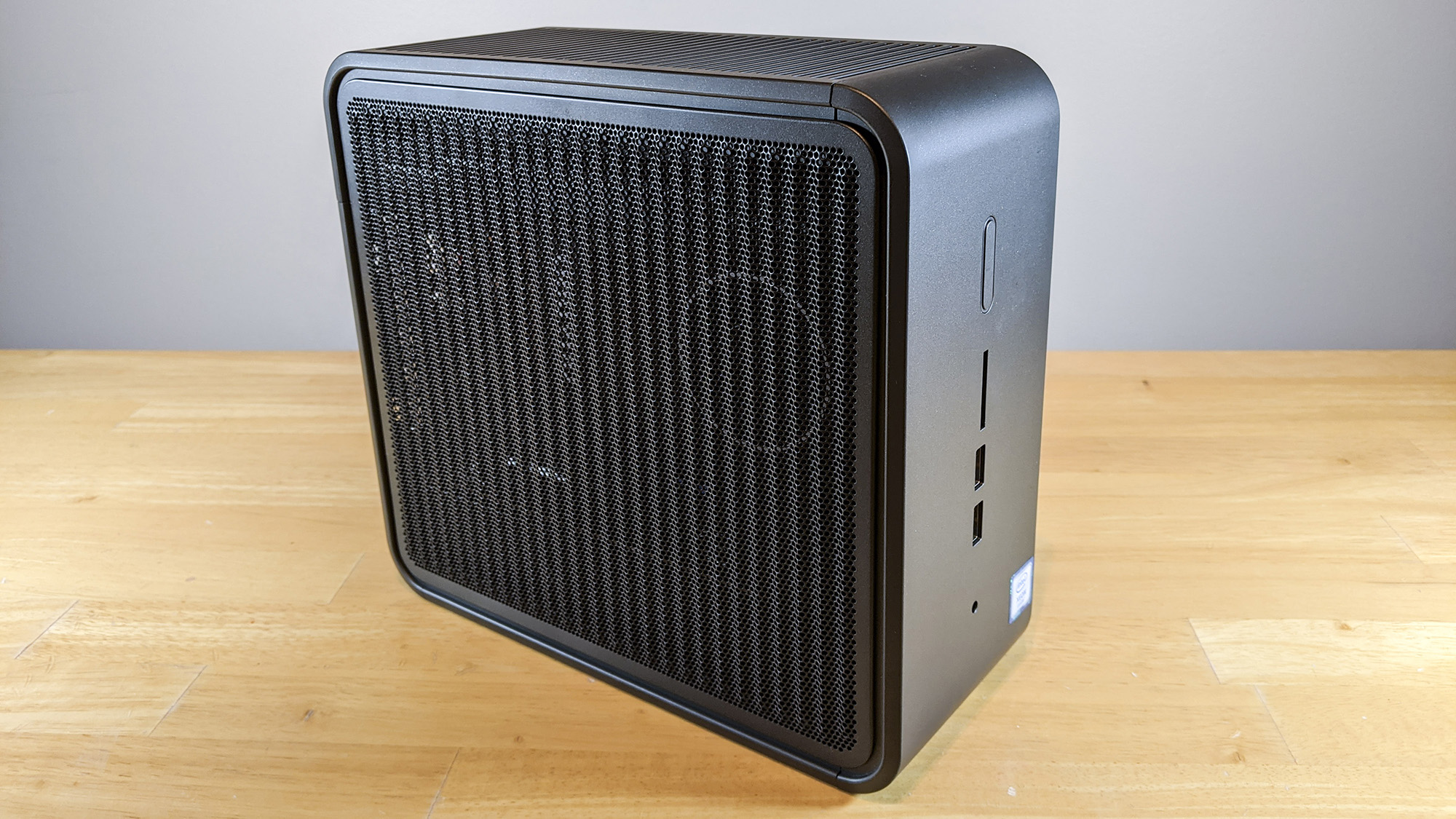
For a certain segment of professionals, the powerful capabilities offered by the NUC 9 Pro as a compact workstation desktop are more than worth the price. And while you can probably find a standard tower desktop design that offers similar specs and power for less, you're also paying for the compact design, and here is where Intel's tiny project really pays off. Getting a desktop with a Xeon processor and Quadro graphics is one thing, but getting them into the 5-liter case that defines the new NUC desktop? Well, that's something kind of special.
Brian Westover is currently Lead Analyst, PCs and Hardware at PCMag. Until recently, however, he was Senior Editor at Tom's Guide, where he led the site's TV coverage for several years, reviewing scores of sets and writing about everything from 8K to HDR to HDMI 2.1. He also put his computing knowledge to good use by reviewing many PCs and Mac devices, and also led our router and home networking coverage. Prior to joining Tom's Guide, he wrote for TopTenReviews and PCMag.
-
Sathinator Reply
You cannot seriously be comparing the Xeon E-2286M processor (worth $623 alone) and a 45W part with the Apple M1, a 15W entry-level part in a machine that costs just $699 total? That the mini/M1 is competitive at all highlights just how dire Intel's predicament is.admin said:The Intel NUC 9 Pro is a workstation mini PC that offers huge power and a surprising amount of upgradability, but fitting all of that into such a small will cost a pretty penny.
Intel NUC 9 Pro mini PC review — crazy speed beats Mac mini m1 : Read more -
andrusoid Not sure how you got that ballpark 6000 M1 Mac score. The Geekbench site currently shows 7398 and using their app locally on my machine delvered a score of 7460, not so far away from your reported score for the NUC. On a machine I paid $650 for discounted. What precisely were you comparing? Let's wait and see what happens when we get 16, 32, and possibly 64 core M1 chips. Won't be long...Reply
